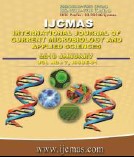


 National Academy of Agricultural Sciences (NAAS)
National Academy of Agricultural Sciences (NAAS)

|
PRINT ISSN : 2319-7692
Online ISSN : 2319-7706 Issues : 12 per year Publisher : Excellent Publishers Email : editorijcmas@gmail.com / submit@ijcmas.com Editor-in-chief: Dr.M.Prakash Index Copernicus ICV 2018: 95.39 NAAS RATING 2020: 5.38 |
Dahi is highly palatable and easily digestible by human digestive system which contains macronutrients like protein, carbohydrates, fat and minerals like calcium and phosphorus. This study aims to screen the antibacterial activity of dahi which is good source of lactic acid bacteria (LAB). Lactic acid bacteria produce certain antimicrobial substance, which plays important role for the antibacterial activity for most of the milk products. The antagonistic properties of dahi against Staphylococcus aureus, Escherichia coli, Pseudomonas, Proteus vulgaris, Klebsiella were examined using agar well diffusion method. Thirty samples of dahi were collected from the Amul (A1 to A10), Local market (M1 to M10) and house hold level (H1 to H10). Industrial dahi (collected from AMUL) and Market dahi were collected from local area of the Anand city. However, the spectrum of inhibition was different for the different sources of dahi (Dracheva et al., 2007). All the samples of dahi exhibited the antibacterial activity against most of all the indicator pathogens. Amongst all the food borne pathogens Escherichia coli exhibited the highest antibacterial activity with a zone of Inhibition (ZOI) ranging from 18 to 21 mm. Industrial dahi showed the higher antibacterial activity against all the food borne pathogens and least antibacterial activity for Klebsiella (11±1 mm). Dahi collected from Market showed higher antimicrobial property against Proteus vulgaris (20 ± 2.0 mm) and least against Staphylococcus aureus. Whereas dahi collected from house showed inhibition of Pseudomonas (21 ± 1.5 mm) and least for Staphylococcus aureus like market dahi. All dahi showed the remarkable inhibitory effect against both Gram positive and Gram negative pathogenic strains.
 |
 |
 |
 |
 |